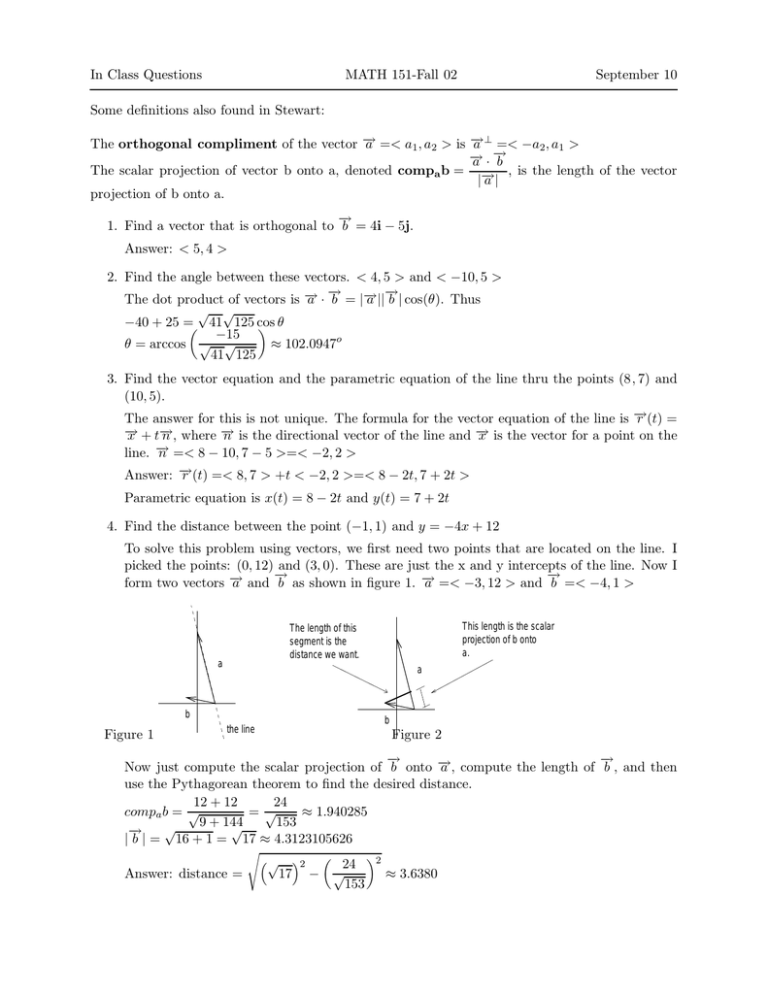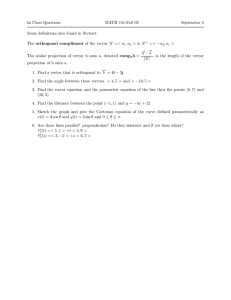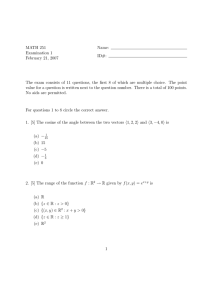In Class Questions MATH 151-Fall 02 September 10
advertisement

In Class Questions MATH 151-Fall 02 September 10 Some definitions also found in Stewart: − − The orthogonal compliment of the vector → a =< a1 , a2 > is → a ⊥ =< −a2 , a1 > → − → − a · b The scalar projection of vector b onto a, denoted compa b = − , is the length of the vector |→ a| projection of b onto a. → − 1. Find a vector that is orthogonal to b = 4i − 5j. Answer: < 5, 4 > 2. Find the angle between these vectors. < 4, 5 > and < −10, 5 > → − → − → → The dot product of vectors is − a · b = |− a || b | cos(θ). Thus √ √ −40 + 25 = 41 125 cos θ −15 θ = arccos √ √ ≈ 102.0947o 41 125 3. Find the vector equation and the parametric equation of the line thru the points (8, 7) and (10, 5). → The answer for this is not unique. The formula for the vector equation of the line is − r (t) = → − → − → − → − x + t n , where n is the directional vector of the line and x is the vector for a point on the → line. − n =< 8 − 10, 7 − 5 >=< −2, 2 > − Answer: → r (t) =< 8, 7 > +t < −2, 2 >=< 8 − 2t, 7 + 2t > Parametric equation is x(t) = 8 − 2t and y(t) = 7 + 2t 4. Find the distance between the point (−1, 1) and y = −4x + 12 To solve this problem using vectors, we first need two points that are located on the line. I picked the points: (0, 12) and (3, 0). These are just the x and y intercepts of the line. Now I → − → − → → form two vectors − a and b as shown in figure 1. − a =< −3, 12 > and b =< −4, 1 > This length is the scalar projection of b onto a. The length of this segment is the distance we want. a a b Figure 1 b the line Figure 2 → − − → → Now just compute the scalar projection of b onto − a , compute the length of b , and then use the Pythagorean theorem to find the desired distance. 12 + 12 24 compa b = √ =√ ≈ 1.940285 9 + 144 153 √ √ → − | b | = 16 + 1 = 17 ≈ 4.3123105626 Answer: distance = s √ 17 2 − 24 √ 153 2 ≈ 3.6380 5. Sketch the graph and give the Cartesian equation of the curve defined parametrically as x(t) = 3 cos θ and y(t) = 2 sin θ and 0 ≤ θ ≤ π. To get this into a Cartesian equation all you need to remember is that sin 2 θ + cos2 θ = 1. 2 Cartesian equation: y 2 2 + x 3 =1 6. Are these lines parallel? perpendicular? Do they intersect and if yes then where? → − r1 (t) =< 1, 1 > +t < 5, 9 > → − r2 (s) =< 3, −2 > +s < 6, 7 > There are two ways to work this problem. →1 =< 5, 9 > and the directional Method 1: vectors The directional vector for line 1 is − n − →2 =< 6, 7 >. Since these vectors are not parallel (not scalar multiples of vector for line 2 is n each other) the line are not parallel. Since the dot product of these two vectors is not zero, the vectors are not perpendicular. Now for the intersection of the lines. rewrite the vector equations as: → − r1 (t) =< 1 + 5t, 1 + 9t > → − r2 (s) =< 3 + 6s, −2 + 7s > → → Since these lines intersect, there is a value for s and t such that − r1 (t) = − r2 (s). This gives the system of equations: 1 + 5t = 3 + 6s and 1 + 9t = −2 + 7s Now solve the system of equations and you find that t = −32/19 and s = −33/19. So the point that they intersect at is found by plugging t into r1 or s into r2 . The point is (−141/19, −269/19) Method 2 The second method is to covert the vector equations to Cartesian equations. for example the parametric equations for line 1 is x = 1 + 5t and y = 1 + 9t. Now solve one of these for t and plug into the other. x−1 5 =t y = 1 + 9 x−1 5 5y = 5 + 9(x − 1) 5y = 5 + 9x − 9 5y = 9x − 4 y = 95 x − 45 Now do the same for the other line. Now you can solve with traditional methods.



